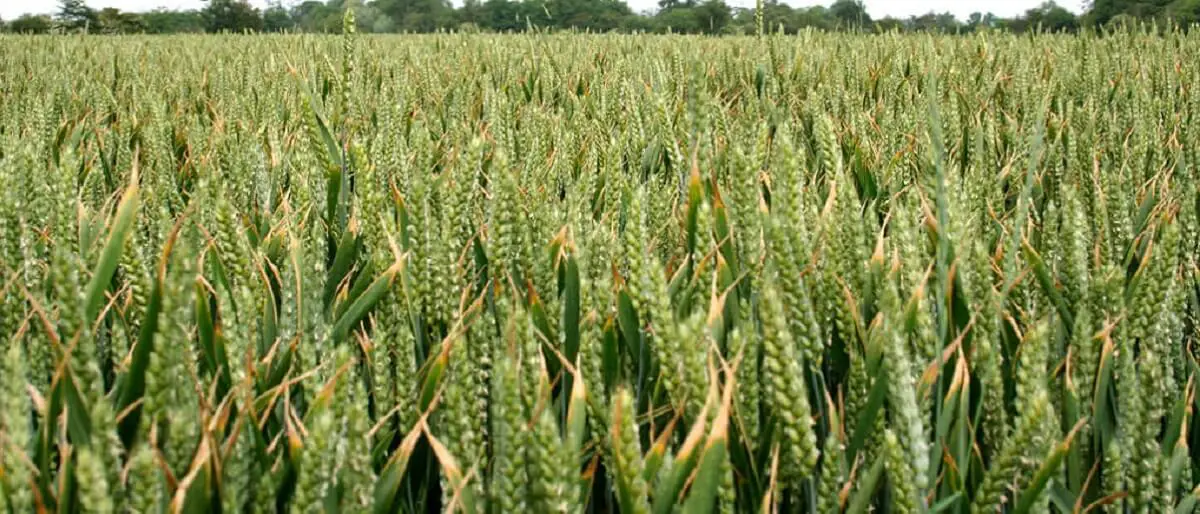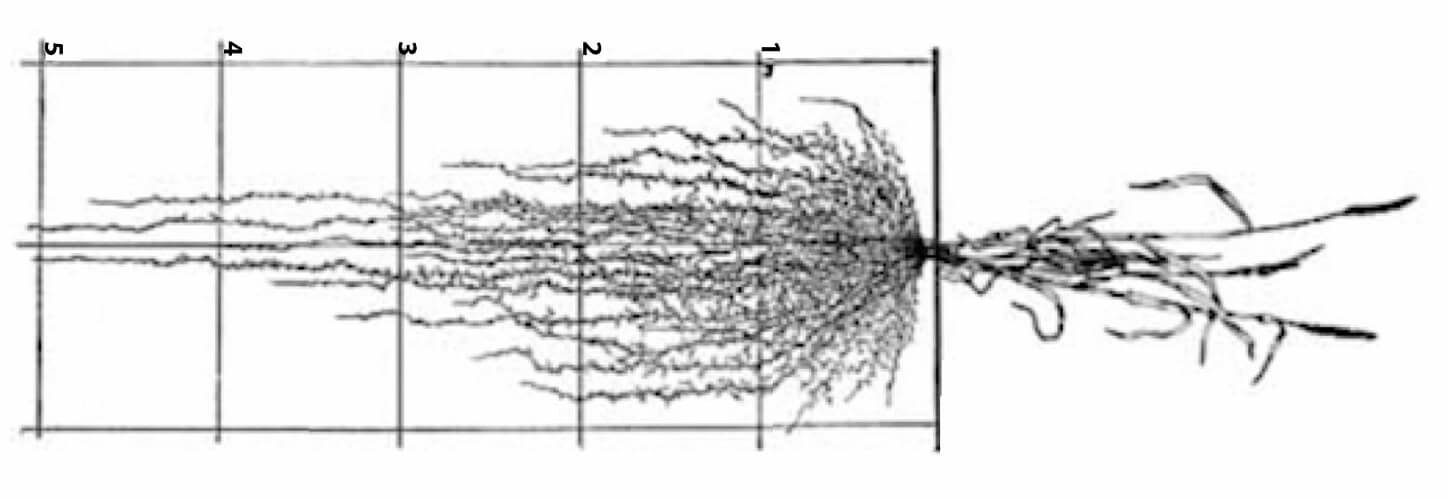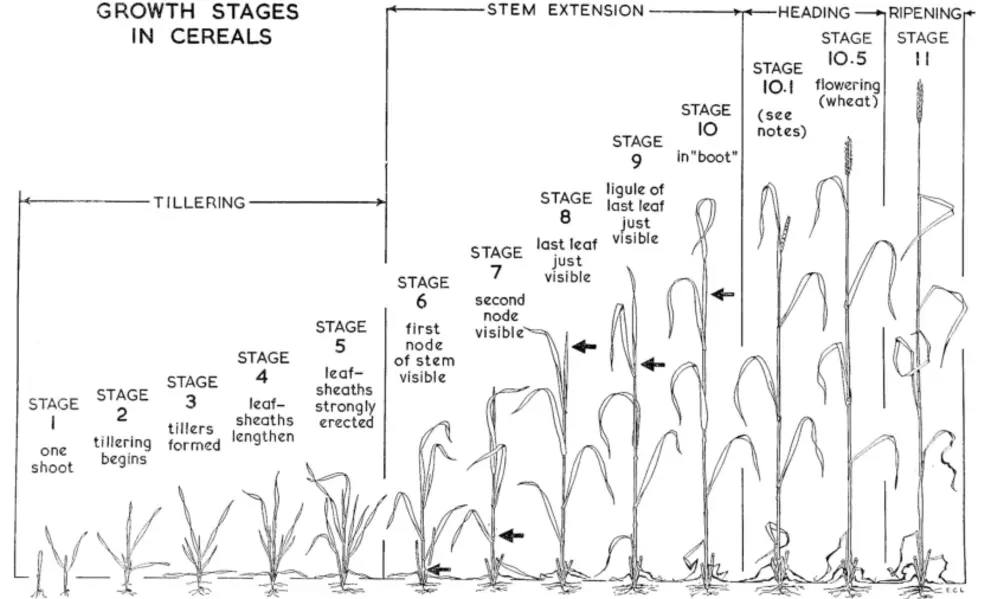Planting Winter Wheat Guide What You Need To Know
Winter Wheat A Green Manure Cover Crop

You can use winter wheat as a cover crop and then use it as green manure the following season. It's a great way to protect our garden's soil from erosion, prevent weeds from moving in and add some organic nutrients to your soil. It will reduce mineral leaching and insects while increasing the soil's aeration and water absorption and retention while helping to improve your next season's crop yield.
It is a hardy cereal that will not die off over the winter, unlike oats, and is great to use on overused or compacted soil.
It also tends to have fewer problems with nitrate than other cereal crops.[9]
We need our soil to have a pH level right around 6.5. We need to keep our pH level above 6.4 to maximize growth and allow our winter wheat to use the nutrients in our soil.
Winter Wheat Planting Dates
It is an annual small grain crop that is generally planted from early September all the way up to late October.
Where I live, I need to have my winter wheat planted the first or second week of September to allow it to grow enough to protect my soil.
You will want to estimate the average time your area gets its first frost. Now take an average of 6 to 8 weeks before the frost date, and that is when you want to have your winter wheat seeds planted.
Winter Wheat Types
List of most common Winter Wheat as a Cover Crop
- 1) Hard Red
- 2) Soft Red
- 3) Durum
- 4) Soft White
- 5) Hard White
Winter Wheat Drilling Depth
We will want to find a nice average between the soil moisture and temperature when seeding our plants.
If we do not place the seeds deep enough, we risk the threat of there not being enough moisture for the seeds to sprout. Especially if you live somewhere with hot, dry weather and little rain.
Planting the seeds too deep also has its own problems. When we plant the seeds too deep, it doesn't only take longer for the seeds to sprout out of the soil but can significantly reduce the number that will be able to emerge.
Deeper depths require the plant to have greater vigor and may stop the coleoptile tiller from emerging.[10] Winter wheat will now have higher chances of developing root rot and increasing its chance of disease.
Winter Wheat Germination Time
Multiple factors will alter how long it takes for our winter wheat to germinate. The depth it is planted, the available moisture, and the temperature can change the germination speed we see.
Temperatures for successful germination to happen are between 39°F(4°C) to 98.5°F(37°C). Ideally, we want the temperature range to hover between 12°F(53.5°C) to 77°F (25°C).
When our soil has adequate moisture and a temperature of 44.5°F (10°C), we can see the seeds germinate as quickly as 3 to 5 days. If our soil moisture is at the permanent wilting point, it will take twice as long (10 days) at the same temperature. When at such low moisture, the germination process can even completely stop.
Winter Wheat Root Depth
Winter wheat was shown to have a root system depth of up to 3.5 feet in only 55 days. It has a quick and well-developed root system compared to most other cover crops.

Factors like the compaction of the soil will determine how quickly and deep the roots can penetrate. But over multiple years, the added organic matter from the sources will allow the ground to be less compacted.
So if the first year, our roots could only make it to a depth of a foot the following season, they should be able to reach a foot and a half to two feet in the same period.
Winter Wheat Cycle
Winter wheat goes through 5 different growth stages.
Winter Wheat Growing Stages
- 1) Tillering
- 2) Stem Extension
- 3) Heading
- 4) Flowering
- 5) Ripening

How Tall Does Winter Wheat Grow
This is going to depend on how long you allow it to grow. I like to cut it down on my plot when it reaches around 2 feet, and then I use the material for my compost.
But if you just leave it and the time and weather permitting, you can see it reach an average of 4 feet tall.[8]
Our winter wheat will come out of dormancy in spring and begin regrowing.
Winter Wheat Fertilizer Recommendations
Nitrogen (N)
Studies have shown to maximize your use of nitrogen and get the most significant yield, the best time to apply it to your soil for winter wheat is during the spring at green up.[1]
If you are growing it in your small garden area, mainly to protect your soil over the winter. All your nitrogen for the plant can just get applied during the fall planting.
Phosphate (P)
For phosphate (P), you must ensure it is available to the winter wheat right at seeding. Phosphate is extremely important and is required for the plant to grow a strong root system.
Suppose there is a low level of phosphate going into winter. In that case, the chances of the winter wheat surviving through the winter are reduced.
Broadcast P may be better than no P. Still, the difference in efficiency between the two applications in winter wheat is very pronounced.[1]
Potassium (K)
We need to look for pale green and wilting leaves or a yellowing happening along the margins of the older leaves. These are signs that you need to add more potassium to your soil.[3]
If your winter wheat shows these signs, it is essential to correct it quickly. Low potassium levels reduce the plant's ability to stand and lower its disease resistance.
From what I could find, most soils will have a high enough level of potassium to support winter wheat growth.
The exception is if you work in sandier soil or one with a history of continuous soybean production.
Winter Wheat Harvest Time
We must not harvest our winter wheat too early at the next season's beginning.
Since it is slower to mature than other cereals, you should not kill it too early. At the start of the season, with everything so wet, you can cause your soil to get compacted if you remove the winter wheat too soon.
I use winter wheat as a cover crop to protect my soil and till it into my garden to act as a source of green manure. I will wait a couple weeks into the spring to ensure that I keep the aeration of my soil.
You can also use it as a green source for your compost if you immediately add it or dry it out and use it as brown material.
Summary
Winter wheat has been growing in popularity with many home gardeners to protect our soil from erosion and increase its fertility and beneficial microorganisms.
Its rooting system helps break up compact soil and improve the root growth of our following plants.
It survives well in most places over the winter, and in the spring, it will come out of dormancy and continue growing.
Many home gardeners use winter wheat as a cover crop over the winter. They then till it into their soil the following season and use it as a source of green manure to improve soil quality.
Similar Articles
Growing Winter Peas
Growing Winter Rye
Growing Winter Barley
[1]https://www.ndsu.edu/agriculture/ag-hub/publications/fertilizing-winter-wheat
[2]https://www.ndsu.edu/agriculture/sites/default/files/2022-06/sf1448.pdf
[3]http://nmsp.cals.cornell.edu/publications/factsheets/factsheet65.pdf
[4]https://www.gardeningknowhow.com/edible/grains/cover-crops/growing-winter-wheat.htm
[5]https://acsess.onlinelibrary.wiley.com/doi/full/10.1002/agj2.20037
[6]https://www.cropnutrition.com/resource-library/winter-wheat-fertilization
[7]https://bsppjournals.onlinelibrary.wiley.com/doi/abs/10.1111/j.1365-3059.1954.tb00716.x
[8]https://www.scirp.org/journal/paperinformation.aspx?paperid=99297
[9]https://www.agriculture.com/crops/wheat/production/top-fage-winter-wheat_145-ar42670
[10]https://extension.umn.edu/planting-small-grains/how-deep-do-i-drill-wheat-barley
[11]https://www.growwinterwheat.ca/growing-winter-wheat/seeding/general-seeding/winter-wheat-stage-timing
[12]https://www.agrifarming.in/wheat-seed-germination-time-temperature-procedure